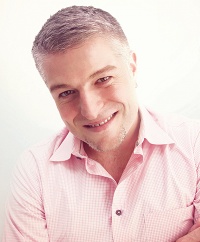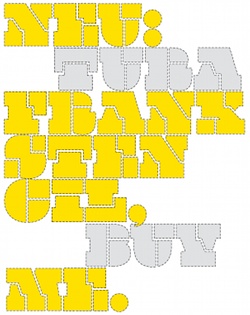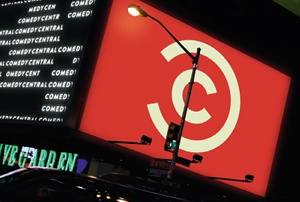Adam Larson: The big league
Award-winning designer Adam Larson talks about his humble beginnings as a freelancer and how he ended up working for MIT and Beyoncé

In his Boston-based studio, a 700sq ft street-level space in the heart of the city, Adam Larson dreams up and creates visual identities for some of the most ubiquitous brands in the US. The high profiles of some – including Beyonc, Nike and K-Swiss – may faze other designers, but as Larson maintains, he still has the same approach regardless of a project’s scope and visibility. “I decided about three years ago to make my work my art,” he explains. “This shift in perception changed everything. I used to resent my design work in a way, because I viewed it as work, and it took time from my art. But by viewing them as one and the same, I no longer have that internal struggle. This personal investment in my design work has strengthened the work as a whole.”
Larson’s first freelance jobs after graduating in illustration from Syracuse University consisted of small print ads, promotional flyers and posters for various local arts organisations. This led to an ongoing gig with The Theater Offensive, a GLBT theatre production company in Boston. “They gave me a lot of freedom, which enabled me to find my voice while learning how to work with a client,” he says. “I gathered enough work for a strong portfolio that eventually landed me a full-time job as a designer at a gaming company.”

While Larson held full-time positions at various companies for the following 15 years, he also maintained a steady stream of freelance clients on the side in order to nurture his design practice outside a corporate environment. No matter how big or small the project, or how fleeting the lead time, he always kept it highly professional. “While I’ve yet to find one direct, replicable path to creativity, my methods are generally the same regardless of the client or project. At the onset of any assignment, I start by gaining as great an understanding of the project goals as possible. My brain automatically kicks into creative overdrive in search of different approaches to the problem. I develop the concepts into sketches and share them with the client. Through several rounds of conversation and revisions, together we eventually evolve them into the best solution possible.
“There are thousands of jobs in the world, and people who become designers generally do so because they want to,” he reflects. “We get to do what we love as a profession, and that’s a true gift – you should never take it for granted. After all, you never know where your next project will come from and who will bring it to you. It’s always important to be kind to people, to not burn bridges and to keep your ego in check.”
Over the years, Larson developed such a strong network that when he went out on his own, project work managed to find him: “In advertising, people jump companies quite a bit, so, for example, art directors and creative directors I’d worked with at Arnold [an advertising agency headquartered in Boston] were now at different companies, and they brought me in as a freelancer to help out with their design and branding projects. The fact that I practice both illustration and design also helped, in that I could take on projects in both fields as opposed to just one or the other.”

So where does Larson find his inspiration before landing a job? “Primarily music, but sources range from fashion and art to nature, science and technology. I have the same love for antiquities as I do for contemporary pop culture,” he says. “Often the things that inspire me the most are completely unrelated to my current assignments, but bringing new ideas to those projects makes them all the more interesting. Keeping an open mind lets you see inspiration everywhere.
“If I were to categorise what I find most inspiring, I’d have to say the surreal,” he continues. “I’m most moved by things that tap into our subconscious and question what’s real, versus what’s perceived. I keep a massive collection of reference consisting of both electronic and analogue materials that I dive into at times for inspiration, but for the most part I try to let inspiration come from within. I believe the answers to everything already exist, and it’s our goal as artists to discover them, and evolve them into something substantive,” he explains.
One of Larson’s most prized clients is the Massachusetts Institute of Technology (MIT), where the designer has carried out some of his biggest projects as a freelancer. Last year, he was invited to respond to a request for proposal (RFP) for the development of MIT’s 150th anniversary identity. It was the Institute’s goal to have a campus-wide celebration, and the identity would be used on all communications surrounding it, including a convocation, symposia, publications and hundreds of events. “MIT has always had a strong appreciation for design and the design process, so the expectations for the identity were very high,” Larson says. “What made the project even more challenging was that it involved many levels of approval within the institution, comprised of a cast of very analytical minds, including the president,” he adds.

After many presentations, it was the simplest solution that resonated with the right people and rose to the top as the chosen direction. The final design was a basic maths equation, MIT + 150, with the tagline ‘Inventional Wisdom’ below the equals line, as if it were the solution to the equation. “The concept allowed for other solutions to replace the tagline, so that anyone could adopt the logo and then create their own use for it,” Larson explains.
So in his years of success, what would Larson say marked his big break? “My second job was actually my dream job – I was working as a designer in-house at a record label. Then again, my experience at Arnold offered me a ton of learning and exposure, so I still attribute a lot of my success to that.
“More recently, I worked with Beyonc and her creative team to design the campaign look and feel, and the packaging, for her most recent album, 4. Given the visibility of that project, I now feel that’s my big break. That said, I hope there continues to be more,” he grins.

Thank you for reading 5 articles this month* Join now for unlimited access
Enjoy your first month for just £1 / $1 / €1
*Read 5 free articles per month without a subscription

Join now for unlimited access
Try first month for just £1 / $1 / €1
Get the Creative Bloq Newsletter
Daily design news, reviews, how-tos and more, as picked by the editors.

The Creative Bloq team is made up of a group of art and design enthusiasts, and has changed and evolved since Creative Bloq began back in 2012. The current website team consists of eight full-time members of staff: Editor Georgia Coggan, Deputy Editor Rosie Hilder, Ecommerce Editor Beren Neale, Senior News Editor Daniel Piper, Editor, Digital Art and 3D Ian Dean, Tech Reviews Editor Erlingur Einarsson, Ecommerce Writer Beth Nicholls and Staff Writer Natalie Fear, as well as a roster of freelancers from around the world. The ImagineFX magazine team also pitch in, ensuring that content from leading digital art publication ImagineFX is represented on Creative Bloq.
